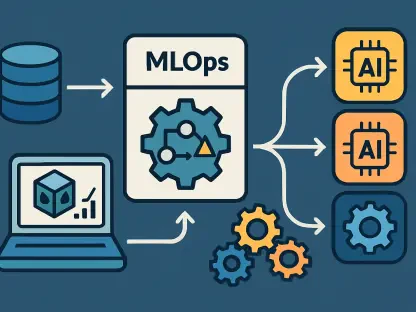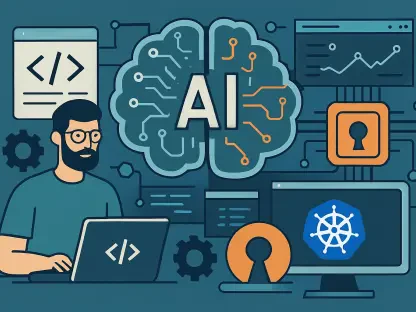The transformative impact of AI on enterprise architecture (EA) is revolutionizing traditional approaches by integrating real-time data processing, addressing inefficiencies, and providing a dynamic and continuously updated system. Architects, supported by AI agents, oversee this evolving landscape with enhanced decision-making capabilities, promoting greater efficiency and relevance within the enterprise.
The Shift from Traditional to Real-Time EA
The Problem with Traditional EA
Traditional EA has long been burdened with inefficiencies, struggling to manage sprawling portfolios with outdated and fragmented tools. EA repositories often resemble outdated storage spaces, filled with obsolete diagrams and deliverables, leaving architects to manage with limited visibility. These antiquated methods hinder the ability of architects to oversee the complex and dynamic nature of modern enterprises effectively. The result is an architectural framework that lacks the agility and responsiveness needed to keep pace with rapid technological advancements and evolving business demands.
Moreover, the traditional approach to EA is characterized by slow and bureaucratic review processes, impeding timely decision-making. Architects find themselves buried under the weight of extensive documentation and slow feedback cycles. The reliance on outdated information contributes to decisions based on inaccurate or incomplete data. These challenges foster an environment where EA struggles to provide clear, coherent, and controlled guidance for an organization’s evolution. There is a growing recognition that EA needs to move beyond these limitations to remain relevant and effective.
The Promise of AI-Augmented EA
In contrast, the emergence of AI-augmented EA introduces a real-time, continuously updated environment supported by intelligent agents and closed feedback loops. This shift towards operationalizing architecture allows for more accurate and timely decision-making within an enterprise. With AI integration, EA evolves into a living system, continuously adjusting and reflecting the current state of the enterprise. Intelligent agents harness machine-readable data and provide real-time updates, ensuring that decisions are based on the latest information.
Operationalization involves embedding architecture within the everyday workflows of the enterprise, transforming it from a static framework into a dynamic process. This approach fosters agility and responsiveness, attributes crucial for thriving in today’s fast-paced business landscape. AI-enabled closed feedback loops play a pivotal role in this transformation, feeding real-time signals into a living architecture graph that accurately represents the enterprise’s state. The continuous updating of this graph ensures that data remains relevant, trustworthy, and actionable, enabling architects to make informed decisions swiftly.
The Role of AI Agents in Real-Time EA
Specialized AI Agents
Various AI agents take on specialized roles to enhance the EA function. Harvesting agents monitor and extract knowledge from digital signals such as continuous integration/continuous delivery pipelines and cloud APIs. These agents ensure that real-time data is continuously fed into the architecture framework, keeping it updated with current operational insights. Dependency agents map digital interconnections, analyzing both structured and unstructured information to uncover logical dependencies and relationships within the enterprise’s systems and processes. Lifecycle-aware agents focus on identifying aging technologies and diagnosing technical debt, providing insights into necessary updates and modernization efforts.
Conformance agents validate proposals against approved tech stacks, standards, and design patterns, ensuring alignment with the enterprise’s established guidelines. Security and cost agents trace implications across risk, compliance, and spending, providing comprehensive oversight of these critical areas. Together, these AI agents create a robust support system for architects, significantly enhancing their ability to manage and evolve the enterprise architecture. The specialized roles of these agents ensure that various aspects of the architecture are continuously monitored and evaluated, leading to a more integrated and responsive system.
Enhancing Architect’s Role
AI acts as a valuable tool for architects, providing continuous data updates and reducing the need for manual information retrieval. AI-powered agents assist with recommending patterns, converting schematics into structured elements, and proposing transition roadmaps, enhancing architects’ efficiency and decision-making capabilities. These capabilities turn the traditional role of the architect on its head, shifting the focus from manual data management to strategic oversight and critical thinking.
The integration of AI allows architects to leverage advanced analytics and predictive modeling to foresee potential challenges and opportunities within the enterprise architecture. By doing so, architects can proactively address issues, optimize processes, and align technology strategies with business goals. The real-time nature of AI-augmented EA ensures that architects are always working with the most current and accurate information, leading to better-informed decisions and more effective outcomes.
Furthermore, AI-driven visualization tools and generative agents provide architects with intuitive ways to explore and present architectural scenarios. These tools facilitate better communication and collaboration with stakeholders, helping them understand the implications of architectural decisions. As a result, the role of the architect evolves to become more strategic, with a focus on guiding the enterprise through its technological evolution while ensuring alignment with long-term goals.
Addressing Common EA Problems with AI
Resolving Outdated Knowledge and Visibility Issues
AI augments architects’ capabilities by surfacing relevant details at crucial decision points, ensuring real-time integration with operational sources. This continuous update of data improves the freshness and trustworthiness of information used in enterprise architecture. Traditional enterprise architecture’s challenge of insufficient visibility is effectively addressed through these real-time integrations, allowing architects to have a clear and accurate picture of the enterprise’s architecture at any given moment. The ability to access and analyze up-to-date information is critical for making informed decisions that drive organizational success.
Moreover, AI-driven insights help architects identify and articulate the relationships and dependencies within the enterprise’s systems. This visibility enables proactive management of potential risks and optimization of resources. As data flows seamlessly from operational sources into the EA framework, architects can quickly identify and respond to changes in the enterprise environment. This level of visibility and responsiveness was unattainable with traditional EA methods, highlighting the transformative potential of AI integration.
Speeding Up Review Cycles and Reducing Fragmentation
Automated pre-checks and draft decision generation accelerate review processes. Unified rendering of architecture artifacts addresses fragmented deliverables, ensuring consistency and coherence across the enterprise architecture. With AI automation, the need for lengthy, manual review cycles is significantly reduced. Pre-checks conducted by AI agents ensure that proposals and changes comply with established standards and guidelines before human review, streamlining the process and reducing bottlenecks.
The unified rendering of architecture artifacts means that all relevant information is integrated into a cohesive and comprehensive view. This coherence addresses the fragmentation issue that has long plagued traditional EA. By presenting a holistic view of the enterprise architecture, AI ensures that all stakeholders have access to consistent and accurate information. This consistency is crucial for aligning various departments and teams with the overarching architectural strategy, promoting collaboration and reducing the risk of misaligned efforts.
Overcoming the Ivory Tower Perception
AI-augmented EA links abstractions to tangible outcomes, enhancing relevance and engagement. This shift addresses the perception of EA as an isolated or detached function within an enterprise. By providing real-time, actionable insights, AI makes the architectural process more interactive and impactful. Stakeholders can see the direct implications of architectural decisions on operational performance, strategic goals, and business outcomes.
The integration of AI democratizes access to architectural insights, allowing a broader range of stakeholders, including product owners, risk managers, and executives, to engage with the architecture. Visualization tools and explainable AI interfaces make complex architectural concepts accessible and understandable to non-technical stakeholders. This increased engagement fosters a collaborative environment where architectural decision-making is more inclusive and aligned with the needs and priorities of the enterprise.
Architects as Prompt Engineers
Evolving Role of Architects
In the AI-augmented EA landscape, architects work as prompt engineers, collaborating with AI systems to define patterns, curate architecture graphs, and design safe evolution paths for systems. Their role evolves to include oversight and judgment while leveraging AI’s advanced capabilities. This evolution transforms architects into strategic leaders who guide the enterprise’s technological journey through critical thinking and expert curation. By working alongside AI, architects can focus on high-level strategic decisions while AI handles routine, data-intensive tasks.
Their collaboration with AI involves defining architectural patterns that ensure consistency and scalability. Architects curate dynamic architecture graphs, continuously updated through real-time data integration, providing a living blueprint of the enterprise’s technological landscape. This continuous curation helps maintain alignment with organizational goals and facilitates the safe evolution of systems. AI’s role in this process cannot be overstated, as it provides the analytical power and computational capacity to manage and interpret vast amounts of data effectively.
Architecting the Future
Architects serve as critical thinkers and curators, guiding AI systems to maintain alignment with organizational goals. The interplay between human skills and AI capabilities ensures continuous adaptation and learning within the enterprise architecture function. This partnership allows architects to leverage AI’s strengths in data analysis and pattern recognition while applying their expertise and judgment to make informed, strategic decisions. As prompt engineers, architects define the inputs and parameters that guide AI’s outputs, ensuring that the AI-generated insights align with the enterprise’s overall strategy.
Architects also play a crucial role in designing and implementing guardrails that govern AI’s actions and decisions. These guardrails ensure that AI-driven processes adhere to established standards, policies, and ethical considerations. By doing so, architects create a balanced and controlled environment where AI can operate effectively while safeguarding the enterprise’s integrity and compliance. This oversight is essential for minimizing potential risks and unintended consequences that may arise from AI-driven decisions.
Addressing Perennial Challenges with AI Integration
Addressing Insufficient Knowledge
One of the most persistent challenges in traditional EA is the insufficiency of knowledge at crucial decision points. AI augments this by acting as a cognitive prosthetic for architects, bringing relevant information to the forefront when needed. This augmentation ensures that architects are always armed with the most pertinent and up-to-date data, thus enabling more accurate and timely decision-making. By providing easy access to a wealth of real-time information, AI empowers architects to make decisions that are both informed and strategic.
Furthermore, with AI-driven analytics, architects can delve deeper into data to uncover hidden patterns and insights that might otherwise remain obscure. This enhanced analytical capability allows for a more nuanced understanding of the enterprise’s technological landscape and its evolving needs. By constantly learning and adapting, AI provides a continuous stream of knowledge that keeps architects ahead of the curve, ready to anticipate and address emerging challenges.
Enhancing Visibility and Reducing Fragmentation
Real-time integration with operational sources ensures that the EA system remains up-to-date, effectively enhancing visibility and reducing the fragmentation of deliverables. Information from various sources is continuously fed into the architecture graph, ensuring that the data mirrors the actual state of the enterprise systems. This fresh and accurate data allows architects to navigate the complexities of the enterprise with greater clarity and insight.
The unified rendering offered by AI integration further addresses the issue of fragmented deliverables. By consolidating data into a single, coherent framework, architects can ensure that all stakeholders have access to a consistent and comprehensive view of the architecture. This unified approach promotes better collaboration and alignment across different departments and minimizes the risks associated with fragmented and outdated information.
Accelerating Review Cycles and Overcoming the Perception Challenge
Automated pre-checks and AI-generated draft decisions streamline and expedite the review cycles, making the architectural process more agile and responsive. This automation reduces administrative burdens on architects, allowing them to focus their efforts on strategic, high-value tasks. Additionally, the increased speed of review cycles means that decisions can be implemented more quickly, helping the organization stay dynamic and competitive in a fast-paced environment.
AI-augmented EA also plays a crucial role in overcoming the ivory tower perception of EA. By linking architectural abstractions to tangible outcomes, AI makes the value of EA more apparent and relevant to stakeholders. This relevance fosters a greater appreciation for the role of EA within the enterprise and promotes a culture of collaboration and engagement. By demonstrating the real-world impact of architectural decisions, AI helps bridge the gap between strategic planning and operational execution.
Feedback Governance and Democratization
Importance of Feedback Governance
Feedback governance is vital in AI-driven EA to maintain control and mitigate unintended consequences. The AI-driven process must be governed by well-defined metrics that ensure the health and effectiveness of feedback loops. These metrics help identify anomalies and deviations from expected patterns, allowing architects to intervene and make necessary adjustments. By continuously monitoring and evaluating the performance of AI systems, architects can ensure that the EA framework remains aligned with organizational goals and regulatory requirements.
Additionally, feedback governance involves designing robust mechanisms for human oversight and intervention. While AI can handle routine tasks and data analysis, human judgment is essential for making nuanced decisions that consider broader organizational implications. This balance between AI-driven processes and human oversight creates a resilient and adaptive EA framework that can effectively navigate the complexities of the modern enterprise.
Democratizing Architectural Insights
The new model of AI-augmented EA democratizes access to architectural insights, making them accessible to a wider range of stakeholders. Chat interfaces, visualization tools, and explainable AI models provide user-friendly means for stakeholders to engage with the architecture. This democratization fosters a more inclusive environment where product owners, risk managers, and executives can actively participate in the architectural process.
By making architectural insights more accessible, AI-augmented EA promotes greater transparency and collaboration. Stakeholders can better understand the implications of architectural decisions and contribute valuable perspectives to the process. This inclusive approach enhances the collective decision-making capability of the enterprise, ensuring that architectural strategies are well-informed and aligned with the organization’s objectives.
Unleashing the Potential of Real-Time EA
Enabling a Living, Learning Function
AI integration transforms EA into a living, learning function that continuously evolves and adapts to changes within the enterprise. This dynamic nature allows EA to remain relevant and responsive in an ever-changing business landscape. By continuously updating and refining the architectural framework, AI ensures that EA can anticipate and address emerging challenges and opportunities.
Architects play a crucial role in guiding this dynamic system, ensuring that it remains aligned with organizational goals. Their expertise and judgment are essential for interpreting AI-generated insights and making strategic decisions that drive the enterprise forward. By combining human ingenuity with AI’s analytical power, the EA function becomes a powerful tool for driving innovation and achieving long-term success.
Architects as Pioneers of Change
In this AI-augmented landscape, architects are pioneers of change, leading the way in leveraging advanced technologies to transform the enterprise. They serve as catalysts for innovation, using their deep understanding of the enterprise’s needs and goals to guide the development and implementation of AI-driven strategies. By embracing AI and its capabilities, architects can create a more agile, efficient, and effective architectural framework that drives the enterprise toward its strategic objectives.
The symbiotic relationship between AI and architects fosters a culture of continuous learning and adaptation. As AI systems evolve and improve, so too do the capabilities and insights available to architects. This ongoing evolution ensures that the enterprise architecture function remains at the forefront of technological innovation, ready to tackle the challenges and opportunities of the future.
Conclusion: The Dawn of a New Era in EA
The transformative impact of artificial intelligence (AI) on enterprise architecture (EA) is fundamentally changing traditional methods by incorporating real-time data processing, thereby addressing inefficiencies and offering a dynamic, continuously updated system. Traditionally, EA has relied on static frameworks and manual data inputs, which often become outdated quickly. However, with the integration of AI, these frameworks now possess the capability to process and analyze data in real-time. This shift not only enhances the responsiveness of the systems but also ensures that the enterprise remains adaptable and current.
AI agents support architects by offering advanced decision-making tools, which significantly enhance their ability to oversee and manage the evolving landscape. These AI-powered tools help identify patterns, predict potential issues, and suggest optimal solutions, making the entire business architecture more efficient and relevant. As a result, AI promotes greater operational efficiency and ensures that enterprise strategies are informed by the latest information and trends.
Furthermore, the integration of AI within enterprise architecture facilitates an environment of continuous improvement. Architects can utilize AI to test different scenarios and outcomes, providing a proactive approach to problem-solving and innovation. Thus, AI isn’t just a tool but a strategic ally in ensuring the enterprise’s success and growth.









